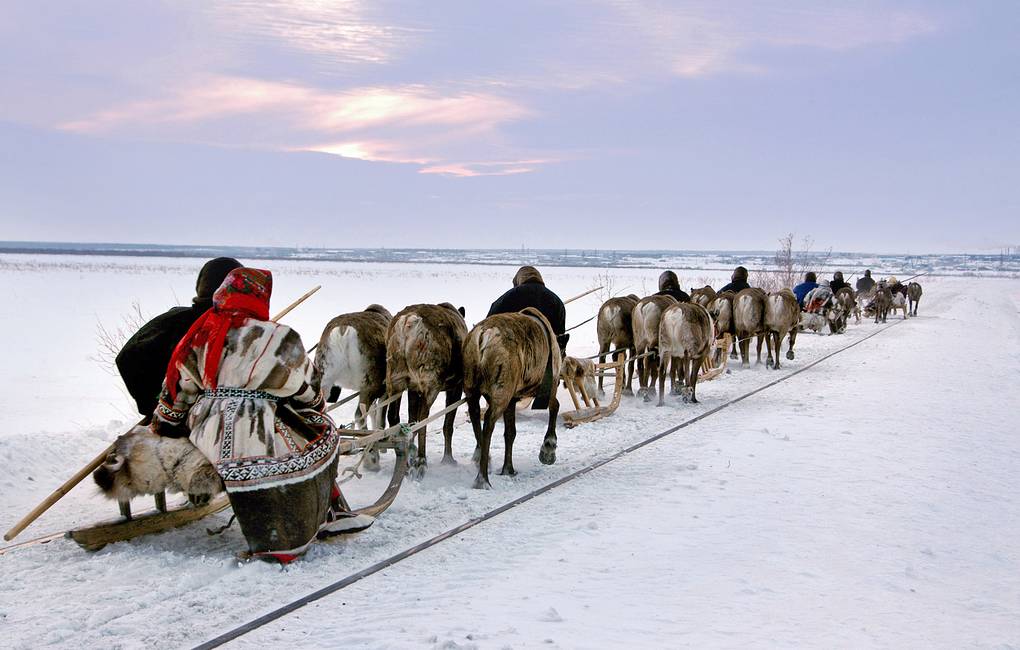Yamal to have base for high meat productivity deer livestock within 5 years
When the scientists finish their work, the target live weight will be not lower than requirements of the Nenets Breed’s standards: 100kg for males, 85-90kg for females and 50kg for calves

06. Россия. ЯНАО. 15 декабря. В районе города Лабытнанги на полуострове Ямал. Фото ИТАР-ТАСС/ Сергей Черкашин
YEKATERINBURG, August 5. /TASS/. The base of the Yamal deer breed livestock with high meat productivity will be raised within five years, expert of the Yaroslavl Research Institute of Livestock Breeding and Forage Production Marina Abramova told TASS. The weight of stags will be more than 100kg, of does – 85-90kg.
According to the regional agricultural department, over recent 30 years the average live weight has slumped to 18% of the standard level.
“We will study how the genotype influences meat productivity,” the expert said. “We plan the work will continue for five years, and the new livestock will become a base of the Baidaratsky Farm’s breed livestock.”
The research institute’s specialists have visited Yamal, she added.
In the past, the Yaroslavl institute supervised livestock breeding at farms in the Moscow, Ryazan, Ulyanovsk, Smolensk and Vladimir regions.
The scientists will work with deer of the Nenets breed. The Yamalo-Nenets Region’s Governor Dmitry Artyukhov has set a task to use selection mechanisms to improve the deer’s heritable qualities in order to raise the animals’ live weight.
“This process is not quick, and the studies and works to improve the livestock have been planned for five years,” the regional agricultural authority told TASS. “The estimated cost will make about 6.4 million rubles ($88,000).”
When the scientists finish their work, the target live weight will be not lower than requirements of the Nenets Breed’s standards: 100kg for males, 85-90kg for females and 50kg for calves.
Livestock’s studies
During the first expedition to Yamal, the experts sampled animals and the moss. Tests are underway.
The work’s target would be to organize in the region a farm with the most highly productive livestock. Specialists will identify a genotype so that breeders could have deer with best features, and so that those features could be inherited. This way, the specialists will raise the livestock’s productivity.
Later on, the region will use the experience at other breeding farms.
Specialists will continue studies in the Yamalo-Nenets Region in late November. They will analyze the livestock, will form the livestock base and will take bio material for immune and genetic tests.
Venison production
From early 2021, under the regional and national agricultural projects, the region has supplied more than 230 tonnes of venison to Finland and about 90 tonnes of non-food 3-class offal to Germany.
In 2020, the region exported to Finland and Germany 390 tonnes, where the biggest part, 360 tonnes, was shipped to Finland. In addition to that, Finland imported 8,400 deer skins. “Besides, last year, to Germany we supplied a 33-tonne consignment of non-food 3-class offal, the so-called slaughterhouse waste, which is used for animal feed production,” the authority said.
The key exporters in the region are Yamalskiye Oleni, Payuta, and Sibirsky Olen companies.
Nenets breed
The Nenets breed of reindeer is the only breed in the Yamalo-Nenets Region. This breed is the most numerous breed in the Sub-Arctic. It is also popular in the north of Europe and Asia. In late 2020, the Baidaratsky Farm received the status of the Nenets breed reproducer. The farm is located conveniently in terms of future supplies of highly productive calves to the Yamal, Shuryshkar, Nadym and Priuralsk districts.
The breed was officially recognized in the USSR in 1985. It is valued primarily for the meat qualities and high growth energy. The animals are adjusted to pastures available in the Arctic zone. Farms in the region also produce antlers. Due to the high endurance qualities, the deer are used in harnesses to transport goods.